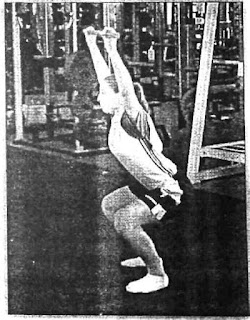The Following tests evaluate the general components of athletic fitness and are useful in designing your off-season training. I like to administer these tests in a weight room or performance training area for preseason training as well as for progress checks throughout the season.
Flexibility Tests
The following tests subjectively measure your total-body flexibility. Flexibility fitness testing should be approached dynamically, not in a static manner. Think of your movements on the field—you need 360 degrees of movement! These tests can be used to quickly evaluate your top-to-bottom flexibility in motion.
Overhead Squat
Objective: Measure total-body (shoulder, spine, hip, knee, ankle) flexibility.
Equipment: A lightweight 7- to 8-foot (2 to 2.4 m) stick (PVC pipe, wood, or broomstick)
Procedure: The test should be done in low-cut socks or barefoot, so that the evaluator can clearly see foot and ankle position. Take a stance that is slightly wider than shoulder width and hold the stick overhead with a wide grip, elbows locked out. The stick should be in line with your shoulder bones. Maintaining this position will be a key observation point when evaluating the exercise. Squat down by flexing your ankles, knees, and hips to the lowest possible position (figure 2.3), Then return to the starting position keeping the stick overhead. Perform a series of 10 squats while a partner observes any deviations in posture (stiffness, loss of balance, lack of coordination) during the descent or ascent of each squat. These limitations should be addressed through a comprehensive flexibility routine that can be performed as part of a warm-up and or cool-down routine.
Figure 2.3 Overhead squat.
Evaluation : The following is a checklist for evaluating the overhead squat
test. Use the answers to these questions to evaluate what areas of your body need attention. Perform stretches from chapter 3 that correspond to these focus points.
Equipment: A lightweight 7- to 8-foot (2 to 2.4 m) stick (PVC pipe, wood, or broomstick)
Procedure: The test should be done in low-cut socks or barefoot, so that the evaluator can clearly see foot and ankle position. Take a stance that is slightly wider than shoulder width and hold the stick overhead with a wide grip, elbows locked out. The stick should be in line with your shoulder bones. Maintaining this position will be a key observation point when evaluating the exercise. Squat down by flexing your ankles, knees, and hips to the lowest possible position (figure 2.3), Then return to the starting position keeping the stick overhead. Perform a series of 10 squats while a partner observes any deviations in posture (stiffness, loss of balance, lack of coordination) during the descent or ascent of each squat. These limitations should be addressed through a comprehensive flexibility routine that can be performed as part of a warm-up and or cool-down routine.
Figure 2.3 Overhead squat.
Evaluation : The following is a checklist for evaluating the overhead squat
test. Use the answers to these questions to evaluate what areas of your body need attention. Perform stretches from chapter 3 that correspond to these focus points.
- Do your feet stay flat? (The heels should not rise during the descent of the squat.) If not, spend time stretching the calves and ankles.
- Do your knees move in or out when squatting down? (Your knees should not move too far in or out during the squat.) This indicates tightness in the adductors (groin area) as well as weak deep hip musculature.
- What is the position of your lower back? (Your posture should not deviate by rounding or arching too much.) Focus on stretching the hip flexors and psoas (deep hip muscles) and strengthening the abdominal and erector back muscles for stability.
- Do your arms come forward during the squat? If they do, this reflects tight shoulder and upper-back musculature.
- Does your head drop forward during the movement? If so, it indicates tightness in the shoulders and neck.
loading...










